High & Low Oxalate Food List
Primal Edge Health participates in the Amazon Services LLC Associates Program and other affiliate programs and therefore, may collect a share of sales or other compensation from the links on this page. This comes at no additional cost to you, and all the prices and availability are accurate at the time of publishing.
Download the printable High & Low Oxalate Food List to help you discern which common foods are high and low in oxalate. This information is essential for anyone interested in successfully following a low oxalate diet.
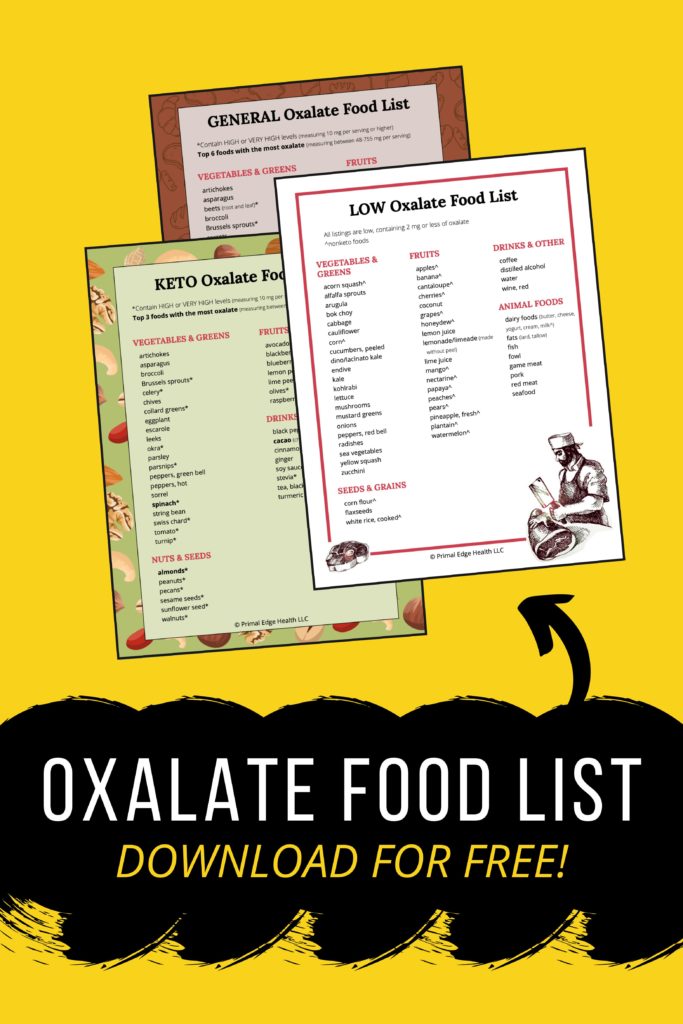
Oxalate is a specific type of antinutrient found in plant foods. Leafy greens, vegetables, fruits, grains, nuts, and seeds all contain varying levels of this compound. Under ideal circumstances, oxalate compounds are eliminated in stool and urine, however, build up can occur.
Oxalate can reduce nutrient absorption by binding to minerals and forming calcium oxalate or iron oxalate. Within published medical literature, the most thoroughly understood consequence of high oxalate levels is discussed in relation to kidney stones. However, with the rise of the keto diet and ultra-low carb/zero-carb diets, more and more anecdotal evidence is accumulating that shines a light on the gaps of our current scientific knowledge.
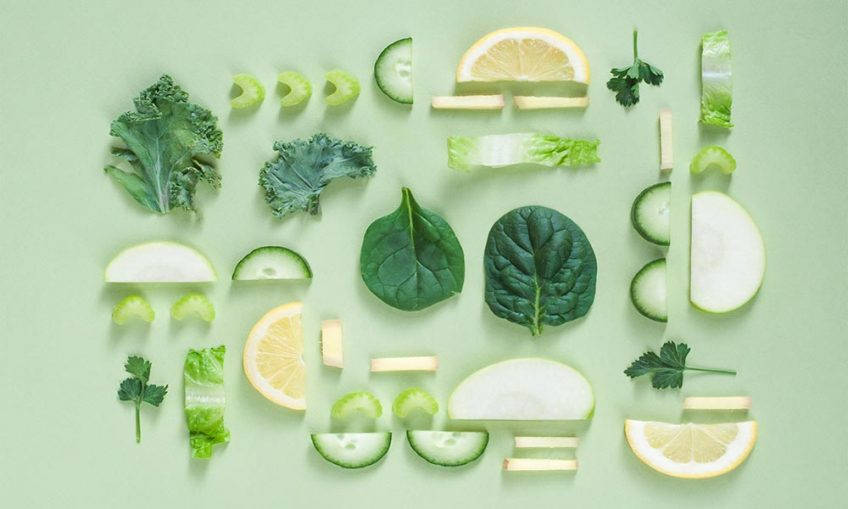
Learn more about oxalate and how it can affect your health
- A brief introduction: “Are these “Health Foods” Killing Us Slowly?”
- Sally K. Norton and Tristan discuss Everything You Need to Know about Oxalates
- Add more fiber-free carnivore diet recipes to your meal plan and see if you notice a difference.
- Consider starting a carnivore diet to reset your health and establish a nonsymptomatic base line.
- Familiarize yourself with low oxalate vegetables.
In our private support forum and broader community at large, we are seeing more and more testimonies on how minimizing the amount of oxalate containing foods may have dramatic results in auto-immune conditions, joint pain, signs of “aging”, and other degenerative conditions.
Of note, a low-oxalate diet isn’t for weight loss, although in some instances, that does occur.
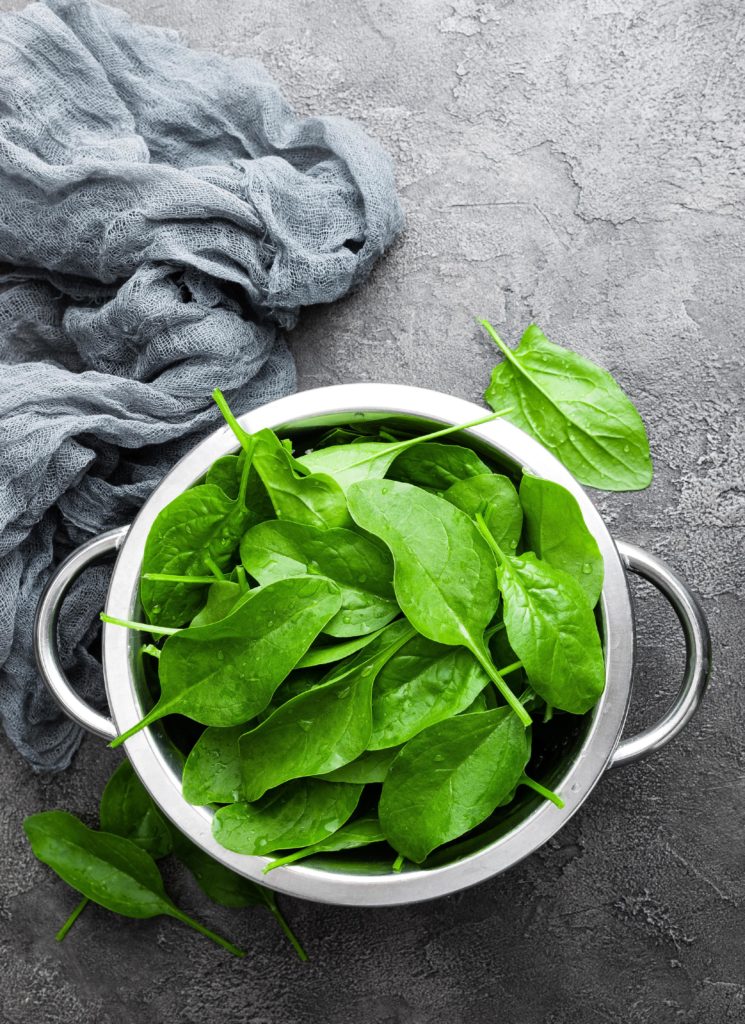
How much is too much?
For general health, practitioners recommend 100mg or less is a good daily goal. A limit of 50 mg a day is even better.
Foods that contain 10 mg or more of oxalate per serving are considered high oxalate foods, these foods should be eaten sparingly or not at all.
Low oxalate foods have less than 2 mg of oxalate per serving. These may be consumed freely.
Animal foods are the only foods that have very little or zero oxalate.
This includes animal protein from ruminants, fowl, pork, fish and seafood; animal fats like butter, tallow and lard; dairy foods (cream, milk, cheese, yogurt etc.) and eggs.
To source quality animal protein, fats, and raw dairy, browse through this collection of directories and link up with local suppliers.
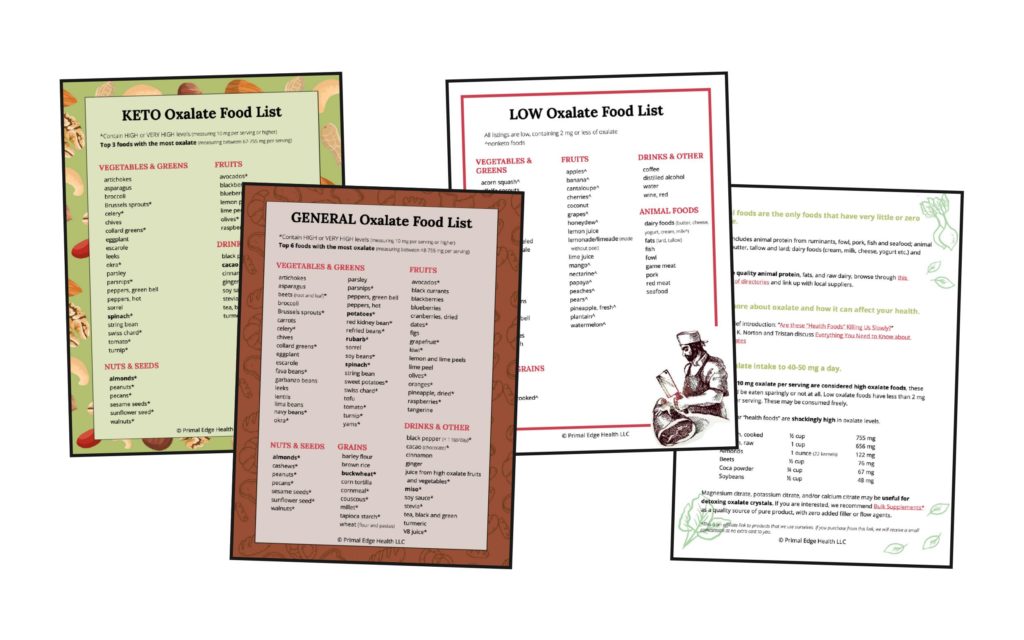
The High & Low Oxalate Food List
The download contains a 4-page pdf oxalate food list: 1 page recaps the information shared here + 3 printable lists. I have separated foods by HIGH and LOW oxalate content as well as KETO and GENERAL foods.
No one has a completely clear understanding on the exact amount of oxalate in every single food. I have done my best to present a general guide to high and low oxalate food by sorting through the most frequently recommended oxalate food lists and consolidated the information by cross-reference.
Some of the highest oxalate foods to be wary of are:
| Spinach, cooked | 1/2 cup | 775 mg |
| Spinach, raw | 1 cup | 656 mg |
| Almonds | 1 ounce | 122 mg |
| Beets | 1/2 cup | 76 mg |
| Coca powder (chocolate) | 1/4 cup | 67 mg |
| Soybeans | 1/2 cup | 48 mh |
Remember the goal of staying under the 50 mg limit a day? Yikes!
These so called “health foods” are literally off the charts high!
You can see how quickly oxalate can add up especially when you eat certain “healthy” foods regularly. You may want to think twice before having a green smoothie for breakfast, spinach salad for lunch, a green juice with your girlfriends on the weekend, and piece of almond flour cake for dessert a few times a week.
“Everyone” says these foods are good for us, but if you are someone who suffers from auto-immune conditions, digestive irregularities, stiffness of joints or general lack of health, I highly encourage you to learn more about oxalate, high oxalate foods, and how your body responds to them.
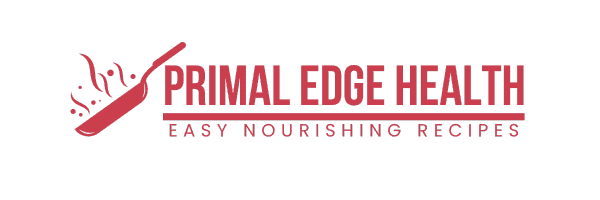

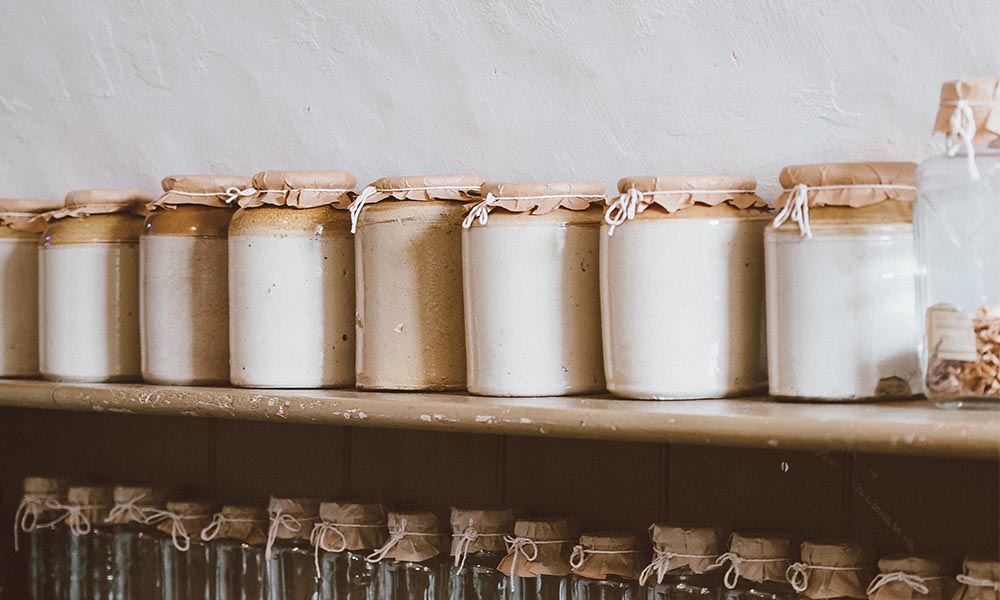
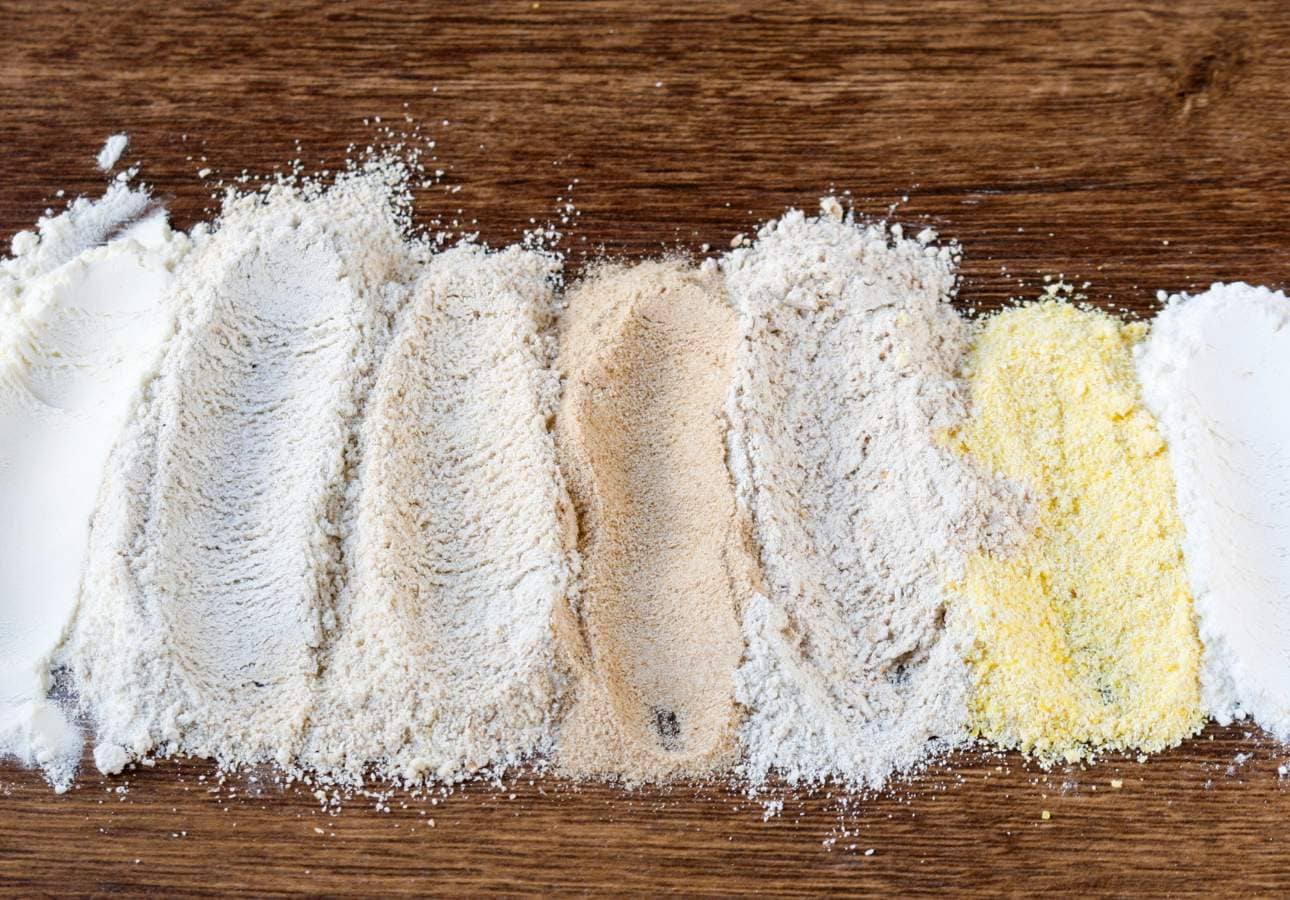
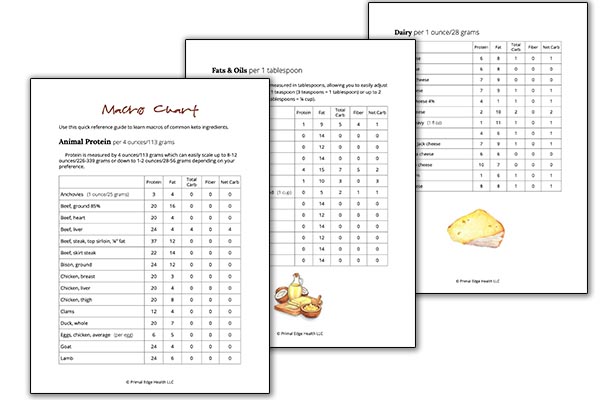
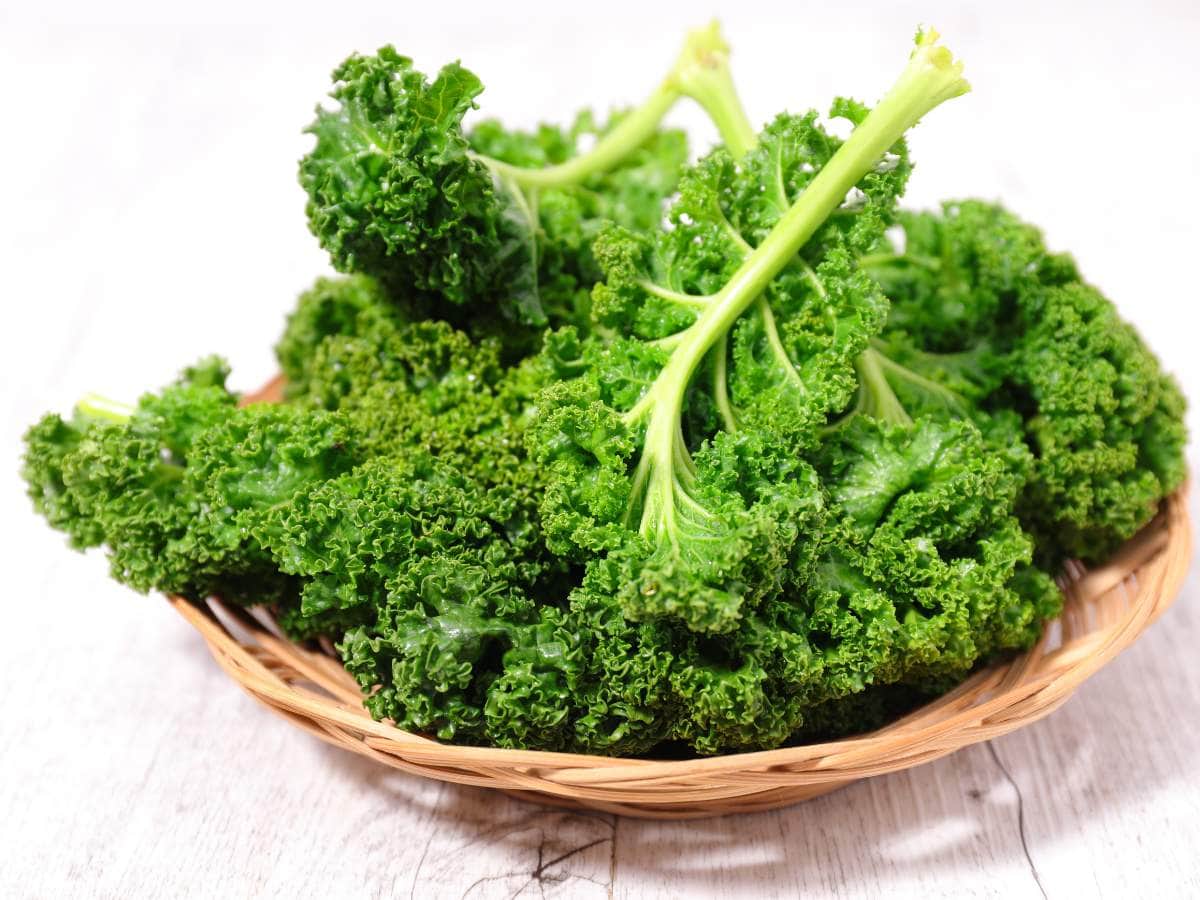

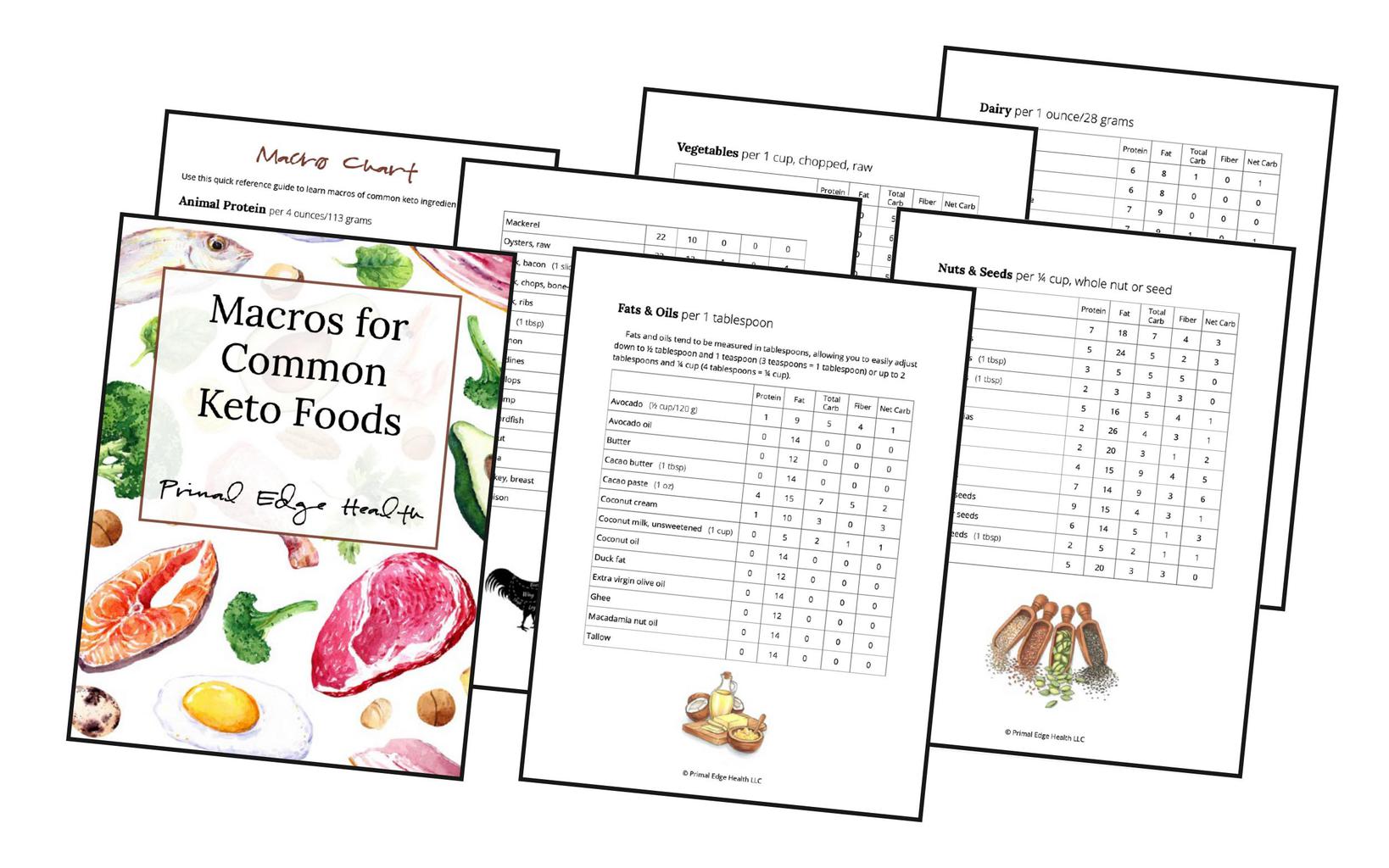
I have had chronic UTI problems for many years which has led to constant antibiotics. I recently found a compounding pharmacy that did a detail blood workup and found my oxalates where higher than anyone they had every seen. I am now on a low oxalate diet and am taking medicine to try and rid myself of my current high levels of oxalates. I think the start of my overload of oxalates is I was vegan for over ten years. A vegan diet is about 100% high oxalate foods, I enjoyed this way of eating and I felt good but I think it really did a number on my system. Looking forward to your list and that you have kept it updated. Wish me luck.
Best of luck Betty! Yes, indeed, the most common vegan foods are very high in oxalate. I hope this list helps you with a clear picture of what to eat and what to minimize. Thanks for sharing your story with me!
I’m having a similar issue with a resistant UTI, for 2 months now. Been on 3 courses of antibiotics, that the bacteria was supposedly sensitive to, but didn’t work. I refused the 4th round. Now I am looking more into oxalates and stones being the issue. Besides a low oxalate diet, what meds did they put you on to help clear the UTi?
Hi Lisa, thanks for sharing your experience. That sounds incredibly frustrating. You’re not alone in wondering about the role oxalates might play in persistent UTIs and related issues. While the High & Low Oxalate Food List focuses on dietary support, especially reducing high oxalate foods like spinach, almonds, and beets, it doesn’t specify any medications used for UTIs or oxalate-related concerns.
Many in our broader community have found relief by switching to a low oxalate diet and even trying out a fiber-free carnivore approach to help establish a symptom-free baseline. That said, because this involves your health and medications, it’s important to consult with a qualified healthcare professional before making any changes or adding treatments. They can help evaluate if oxalates or stones are contributing to your symptoms and guide the best course of action.
If you haven’t already, you might find the downloadable oxalate list helpful for meal planning. You can find it in the post to get started with identifying high and low oxalate foods. Wishing you clarity and healing on your journey, Lisa!
The reason I need to eat low oxalate foods is because I’m now prone to calcium oxalate kidney stones since cancer surgery messed up my hormones and lymphs in 2019. According to the urology/kidney doctors, I’ve also been told to limit protein because too much protein can also cause kidney stone formation as well. I wonder if Sally K. Norton talked about the role of oxalates and kidney stones? I love meat but how can I go on a completely carnivorous way of eating if the protein is just going to give me kidney stones anyway? Where can I hear the whole conversation between Sally and Tristan? From the portion that I heard here on this page, it was a great discussion and I’d be interested in hearing more. By the way, I found your site by searching for “low oxalate foods list”. Thanks! Peace.
I hope this interview is helpful in your journey Anita. Here’s a link to the full podcast: https://www.primaledgehealth.com/ep-249-sally-k-norton-oxalates/
God bless!
Hi Anita,
I am going through the exact same thing. I have had many surgeries for Kidney stones that are very large. They have told me I need to cut way back on protein and Oxalates .
It’s definitely a new way of learning what, how to eat/ Cook.
I wish you all the best and hopefully pain free soon .
Sue
hello, am i not seeing where to download the Oxalate List? thank you
Hi there, sorry for the confusion! You are welcome so subscribe to the blog here and I’ll send you the food list to your inbox. The opt-in form is directly under the first image. I’ll make an adjustment here now so it’s more clear for others. Thank you for the comment. Please let me know when you receive the list!
Can you send me the link fir oxylate menus IR food lists
Mahalo
Hi Tiare, I’m not sure what a IR food list is. Currently, I do not have any low oxalate menus or meal plans published. However, this is on my to-do list, and I hope to get to it soon!
Thanks for this information.
However, I clicked on the link to the low oxalates list, and it took me to the offer for the carnivore diet guides, which I’ve already purchased, and there is not low-oxalates food list included. What is the correct link?
Thank you.
Hi JeanMarie, I’m sorry for the confusion! After signing up, you should see an email in your inbox with a link that gives you access to the list. Let me email you privately and we can sort this out.
Exactly what I was looking for. Access to a simple list without having to subscribe to a whole diet plan lol
I’m happy to send it to you Deb! I hope it’s a great help!
I am in tears today I’m so confused what I can and cannot eat I have had several kidney stone removals. I’m so frustrated on what to do.
I feel for you Anita! Follow the suggestions from our list and learn what you can from the resources I linked in here. There is hope! Your body CAN thrive!
A few years back I stsrted juicing and eating more plant based. I was eating a boat load of spinach,chomping on raw almonds by the handful and including cooked greens in almost everything I could think of because I just assumed from all of the reading I had done that eating massive quantities of greens and legumes was like the pillar of health. Man,did that back fire on me when I developed interstitial cystitis. The first thing the drs gave me was a list of all the foods I should avoid and amongst the list besides acidic ones were all of these high oxalate foods to avoid…and of course it contained all of the foods I had been eating in big quantities. :/ I wish I had done more research on the dangers of eating plant based,it would have saved me from the excruciating hell of ic. So thankful to have found yall’s page ? I consider myself healed mostly these days and it helps to stick to a more ketogenic primal diet,so grateful!
You would think that all these foods are pillars of health, “everyone” says so! So glad you could correct your food choices and are feeling well now! #SteaksOverCakes xx Jessica
Thanks guys! I was doing keto, with lots of ‘healthy’ greens, avocados, and nuts. Then I heard about palates, coincidentally when I was having some pain from kidney stones. I am now feeling a lot better on a carnivore diet. I include coffee and coconut oil. Thanks very much to Sally Norton, Tristan, and Jessica!! xx
Tristan and Sally had a great conversation the other day, you can listen to it here if you haven’t already https://www.youtube.com/watch?v=AfNfehT5F2g I’m so glad you find this information useful and are already feeling better!